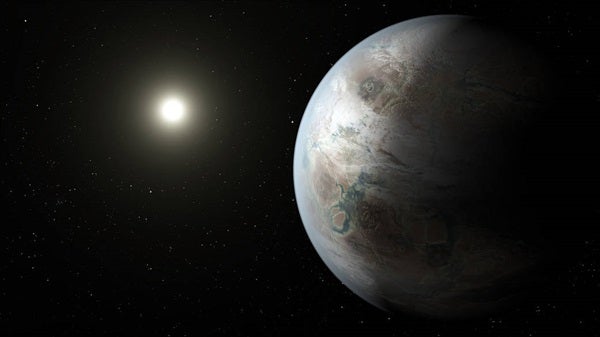Astronomers know of thousands of planets circling other stars. Although many of these worlds are bizarre beyond imagination, some are surprisingly Earth-like. So, to help search for any possible life on those planets, researchers often use so-called biosignatures as proxies.
Biosignatures are substances or other clues that point to life, serving as indirect evidence of its presence. On Earth, the oxygen in our atmosphere is one of the most glaring biosignatures that an alien astronomer might notice: It’s only in our atmosphere in such great quantities because photosynthesizing plants and bacteria have produced it for billions of years.
The biological origin of Earth’s oxygen is partly why human astronomers want to search for it in the atmospheres of nearby Earth-like exoplanets, especially when long-awaited and cutting-edge facilities such as the James Webb Space Telescope come online. But a new paper published April 13 in AGU Advances warns that rocky planets around Sun-like stars could develop oxygen atmospheres without any help from life at all. This means that simply detecting oxygen might not be the smoking gun researchers once thought it could be.
Searching for signs of life
First things first: Why isn’t oxygen expected in the atmosphere of a lifeless rocky planet?
Most oxygen in a fledgling planet’s atmosphere takes the form of water, or H2O. And during a Sun-like star’s early years — called the pre-main sequence phase — that star emits intense ultraviolet (UV) radiation. This UV light breaks apart a planet’s atmospheric water molecules, separating the hydrogen from the oxygen. The lighter hydrogen atoms then drift off into space, leaving the heavier oxygen atoms behind.
But Sun-like stars have particularly short pre-main sequence phases — on the order of about 50 million years. This isn’t enough time for the above process to yield much oxygen. Indeed, this was true of our own solar system, too. Shortly after its formation, Earth’s atmosphere contained mostly nitrogen and carbon dioxide. That only changed a little over 2 billion years ago, thanks to the development of a form of life called cyanobacteria, which converts carbon dioxide to oxygen.
Over the course of some 10 million years, biologically produced oxygen supplanted carbon dioxide as the second most prevalent component of Earth’s air (after nitrogen). Good old O2 now makes up roughly 20 percent of Earth’s atmosphere.
Three paths to an oxygen atmosphere
Based on all this, oxygen is one of the most compelling biosignatures that astronomers hope to find in the atmospheres of Earth-like exoplanets around Sun-like stars. But this new study cautions there are cases in which oxygen can accumulate abiotically, or without the presence of life. The results are based on new computer modeling of how rocky planets like Earth evolve, morphing from their early molten stages to solid and stable bodies over the course of several billion years.
Planet evolution is a complex process that depends on several factors. And one very important factor is a world’s initial mix of materials, which includes rock, water, and volatile elements that vaporize at relatively low temperatures (both carbon dioxide and water are considered volatiles). The researchers’ model allows for different initial compositions, generating a huge range of possible planets and atmospheres. The model also factors in geochemical processes, which can add or remove oxygen from the planet’s atmosphere. This makes it more complex and comprehensive than previous models, which only consider processes that occur in the atmosphere itself.
The researchers first tested their model by trying to exactly recreate Earth. “If you run the model for Earth, with what we think was the initial inventory of volatiles, you reliably get the same outcome every time — without life you don’t get oxygen in the atmosphere,” said study first author Joshua Krissansen-Totton at UC Santa Cruz in a press release.
But when moving on to modeling planets with different initial conditions than Earth, “we also found multiple scenarios where you can get oxygen without life,” Krissansen-Totton added. In fact, they found three main paths for a rocky planet to gain an oxygen-rich atmosphere without the presence of life.
The first scenario is an Earth-like water world with oceans whose volume is 50 times (or more) greater than Earth’s. All that water puts high pressure on the planet’s crust, which shuts off geologic activity. This puts a stop to things like weathering and the melting of rock, which both remove oxygen from the atmosphere.
The second scenario is the opposite: A dry, desert world with less than 0.3 Earth oceans effectively ends up with a solidified surface and a “steam atmosphere” of water for a period of about a million years. This ultimately provides a big reservoir of atmospheric oxygen, as sunlight breaks up the water molecules and the hydrogen escapes to space. And because the planet’s solid desert surface can’t remove any oxygen, it stays in the atmosphere.
The final way for a lifeless planet to boast an oxygen atmosphere is if the world initially has a higher carbon dioxide-to-water ratio than early Earth. In this case, the planet experiences a runaway greenhouse effect (think Venus) and becomes too hot for oceans to form in the first place. It’s also too hot for volatiles to exist in the planet’s mantle, where they would otherwise sequester oxygen through chemical reactions. Instead, these volatiles stay in the atmosphere, where they’re unable to remove the oxygen.
So, what’s the prognosis for using oxygen as a biosignature? Fortunately, it’s still pretty good.
“This [study] is useful because it shows there are ways to get oxygen in the atmosphere without life, but there are other observations you can make to help distinguish these false positives from the real deal,” Krissansen-Totton said. “For each scenario, we try to say what your telescope would need to be able to do to distinguish [non-biological oxygen] from biological oxygen.”










